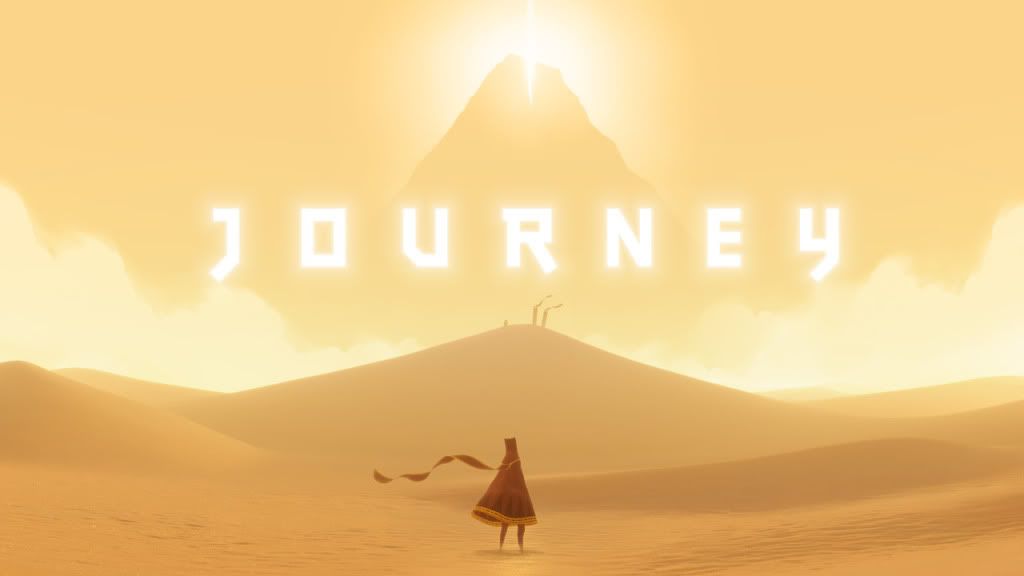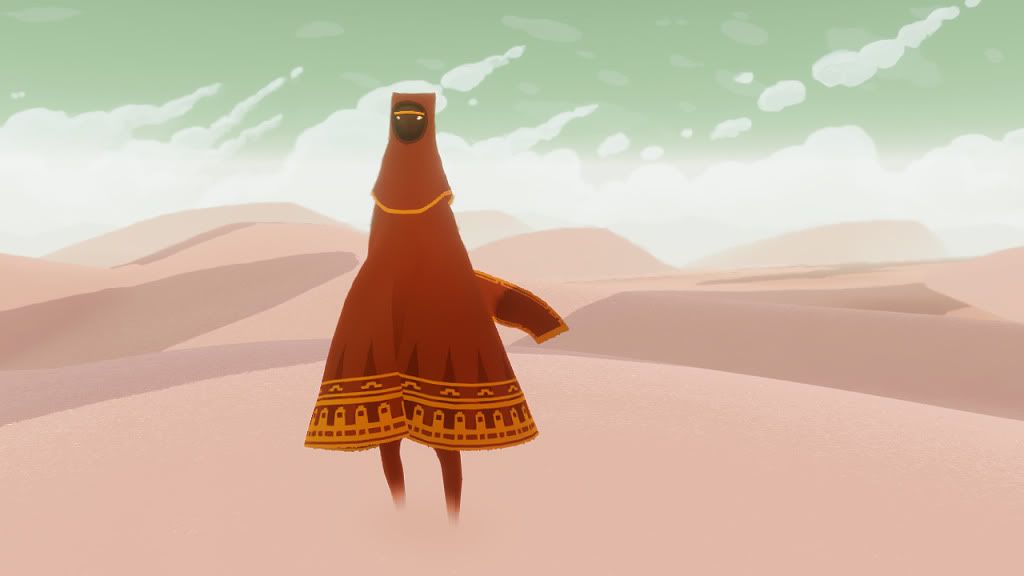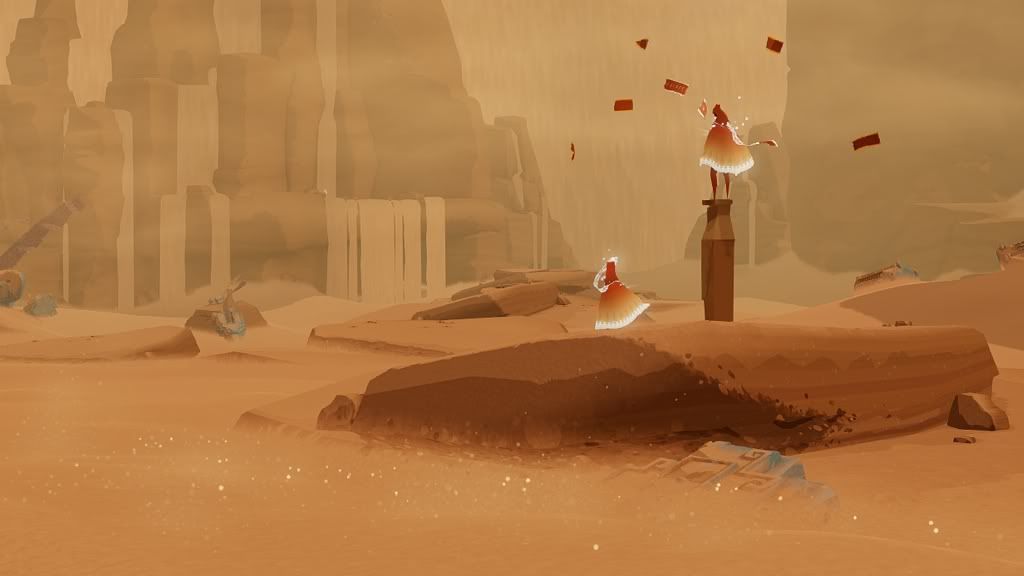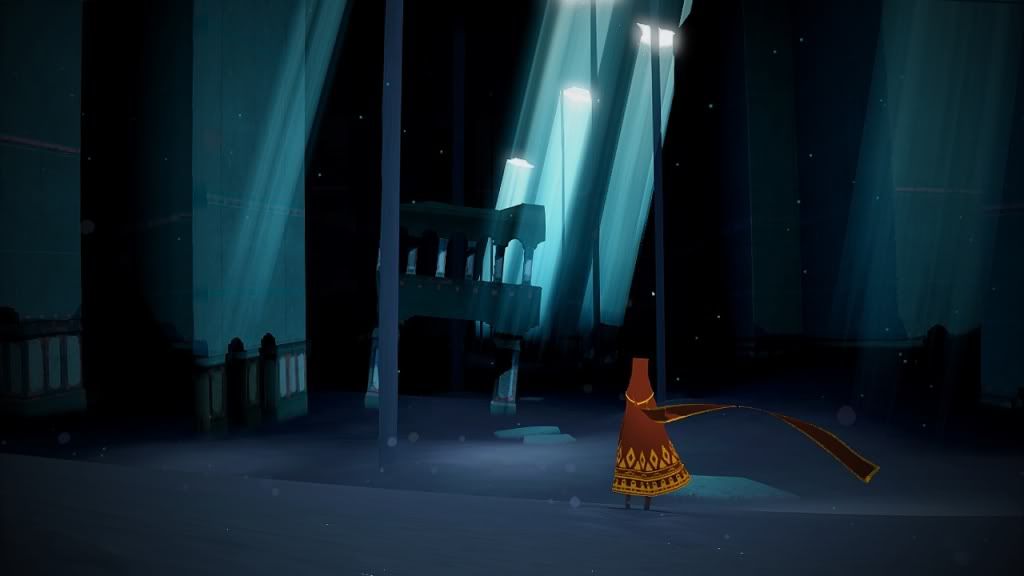
Journey, the latest game by thatgamecompany, is an odd game to describe let alone write about. Very much like their previous works Flow and Flower, Journey aims to provide a thought provoking experience more than push the player with technical challenges. It straddles that border between being a game and being art. Does Journey sit tight atop that border, or does it falter to one side?

One thing about Journey that is noticeable to anyone who plays it is the minimalist approach the game takes. There are no elaborately drawn out scenes, no fancy voice work or stretches of dialogue, or cities filled with characters to interact with. You start as a nameless robed creature in the desert, and find yourself drawn toward the mountaintop in the distance. There are hints at a history or back story within Journey by the way of hidden murals and the occasional brief scene between each section of the game. Aside from these moments, Journey leaves it up to players’ imaginations to interpret and fill in the blanks.
Even from a game mechanics standpoint, Journey is very simple. You can move about, jump/fly for a limited time, and emit a chirping tone. The ability to fly is regulated by the character’s scarf, which can be extended by picking up glowing glyphs that are hidden throughout the world. The controls are responsive and smooth, and you’ll feel in control of your character at all times. At its core, Journey seems like a simplistic platformer, and the platforming that is present is not difficult. However to dismiss it because of its simplicity would be a disservice to what makes Journey memorable.

Initially, players may feel as though they are the last surviving creature in the world. Moving through the desert, there isn’t much aside from partially buried ruins that you wonder through. This feeling of isolation and desolate world makes a key moment early in the game more meaningful: the moment you run into another creature just like yourself. This other creature is actually another player that is currently progressing with his own journey online. You are never given or shown his name, nor can you speak with via voice chat. The only form of communication is through the chirping sound each player can emit.
Once you meet someone in Journey, it is the player’s choice for what to do. You can join up with the other player and continue your journey together, or you can just ignore him and move on by yourself. The other player has the same choice in the matter; he may travel with you for the rest of the journey, or maybe just for a small stretch before parting ways. I will say though journeying with another player is one of the most defining experiences of Journey.
Despite a lack of communication outside of chirping, I found myself actually forming bonds with each player. We would lead each other around wondering about the world, emitting chirps when either notices something in the distance, knows of something hidden, or just as mild banter. The lack of voice chat makes players devise a means to communicate with others which surpasses the traditional language barrier. It makes each player interpret what the other may or may not be trying to say, and somehow it actually works.

It reaches a subconscious level of understanding between players that very few games ever do. Eventually, I understood my unknown partner well enough that we could feel what the other was trying to do at any time. A particularly serene moment was working side by side to fly across the open sands, alternating our chirps to recharge our scarves repeatedly. It was amazing that we coordinated something like that without a single word spoken between us. The bond grew to the point that I found myself lost anytime I was separated from my fellow journeyer, only to feels incredibly elated once I found him again. It is a surreal experience that words cannot really convey fully.
What really envelopes the experience of this journey is the environments and lighting. Journey is an amazing game to look at with its semi-cel shaded look. It is also varied at just the right moments to keep things from becoming stale. Whether it is traveling through the desert, the ruins of a sunken city, or an underground cavern, it seems like around every turn is another wondrous sight to behold. Every setpiece moment in Journey seems to evoke specific moods, and the lighting really helps to enhance that mood. Surfing across a stretch of sand actually feels amazing and exciting when the sand seems alive and flowing like an ocean.

Additionally, the orchestral score that is backing Journey is absolutely beautiful. The composition done by Austin Wintory hits all the right notes at the perfect times. With each area in Journey setting specific moods and feelings, the music completely complements those moods and enhances them beautifully. If you have a pair of headphones, Journey’s soundtrack is worth plugging them in and listening closely as you adventure on.
If there is anything could be levied against Journey as negative, it would be that it is short in length. One play through of the game should take most people no more than three hours to complete the game the first time; even less on subsequent plays. However, it could be said that Journey is a game that really should be played through in one sitting. If it were any longer, players would break up the game into smaller sessions, and potentially miss out on experiencing that bond with other players. There's a powerful message to be conveyed, and it may lose some of its meaning when part of the experience is stifled.
In the end, Journey is by far one of the most engrossing game experiences I have had in recent memory. It is gorgeous to look at and listen to, and the non-traditional setup for co-operative play makes players interact with each other in ways that we take for granted. Unlike numerous games that guides players by the hand over every detail, Journey nudges the player with a minimal amount of detail and lets them use their imagination. While the experience is short, it is a sweet memorable ride that will leave gamers talking about Journey years down the road.
|
+ Evokes emotions out of players + Unusual co-op system actually works + Gorgeous environments + Beautiful orchestral score |
| - A bit on the short side |
Final Grade: A

No comments:
Post a Comment